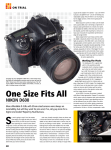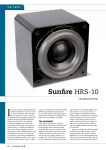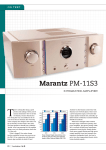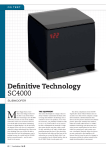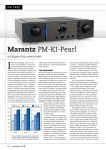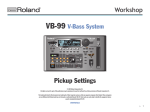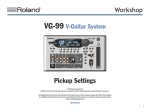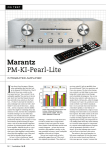Download PSB HD8 Subwoofer Review and Test
Transcript
ON TEST PSB HD8 Subwoofer T he HD8 was one of PSB’s very first ‘ultra-compact’ subwoofers. It was first released in the company’s home country (Canada) back in 2007, so you see that PSB is not one of those companies that release a new model every year, and the fact that the HD8 is still in PSB’s line-up is equally proof of its popularity. Much of that popularity stems, no doubt, from the HD8’s décor-friendly size and at just 297×270×287mm (HWD) it’s certainly small, if not quite small enough to qualify as the smallest subwoofer I have ever seen. (The actual cabinet is slightly smaller than the dimensions above, which include the feet, which lift the subwoofer 28mm from 40 Australian the floor, as well as the protruding speaker terminals, plus take into account the fact that the grille protrudes slightly from the front baffle.) However this PSB subwoofer is certainly small enough that in North America, where they still understand such things, the HD8’s size is often referred to as being ‘less than a cubic foot.’ The Equipment The PSB HD8 was designed by Paul Barton (PSB stands for Paul and Sue Barton) and thanks to Barton’s unique access to Canada’s largest anechoic chamber at the National Acoustics Laboratory, which was Floyd E. Toole’s haunt before he moved to head up loudspeaker research at Harman International (he has since retired), Barton knew that he’d have to pull out every trick from the loudspeaker designer’s hat to extract authoritative bass from the HD8. As Barton well knows, as the volume of any speaker cabinet diminishes, and the bass driver’s effective cone area gets smaller (which in turn has the effect of reducing cone excursion, or ‘throw’), the harder it is for the system as a whole to deliver authoritative bass. In the PSB HD8, PSB uses a single bass driver, the output from the rear of which is used to drive two high-mass passive radiators (‘drone cones’) that are positioned on opposing sides of the cabinet in order to PSB HD8 Subwoofer cancel reactive forces. All three speakers are rated as being ‘8-inches’ in diameter, and the front-firing ‘active’ driver is quoted as having a ‘poly-coated fibre cone with a high density rubber surround’. I couldn’t check the actual diameter of the active cone, because it’s hidden behind a perforated steel mesh grille that can’t be easily removed. I could, however, quite easily check the diameter of the two passive radiators. My tape measure put the overall diameter at 216mm, and the ‘cone’ diameter at 130mm. In fact, as you can see in our photograph, the passive radiators are a ‘flat plate’ design, as originally pioneered by KEF in its legendary B139 design, rather than conical, which is why I put the word ‘cone’ in inverted commas. Because I could not easily remove the passive radiators, I could not determine if they were just, literally, suspended plates, or the visible part of an otherwise conventional moving system, without a magnet. I also could not determine the construction of the driver chassis, which according to PSB has an ‘extra-heavy-duty aluminium cast basket, an oversized magnet (2.3kg) and a large-diameter (70mm), ultra-high-power voice-coil.’ I was rather surprised to learn that PSB is not using a Class-D ‘digital’ amplifier inside the HD8... I didn’t know quite what to think about PSB’s explanation of why there are two large passive radiators fitted to the HD8, because it reads: ‘To overpower the laws of physics the HD8 employs heavy passive radiators “fool” the HD8 cabinet into behaving as (if it were) a much larger enclosure with much larger, longer ports.’ I didn’t know what to think because I actually object to the idea of telling consumers that you can ‘overpower’ the laws of physics, or to ‘fool’ them because you can’t: That’s why they’re called laws. PSB itself is aware of this, which is why it’s put inverted commas around the word fool. I do, however, concede that if you were preparing a ‘dummies’ guide to subwoofer design that PSB’s explanation would be as good as any one that I could come up with. I was rather surprised to learn that PSB is not using a Class-D ‘digital’ amplifier inside the HD8 but instead uses a BASH amplifier that it rates with an output of 500-watts. BASH, which stands for Bridged Amplifier Switching Hybrid, is a trademark owned by US company Indigo, which holds US patents (#5,075,634 and #5,510,753) for this amplifier type, which is essentially an analogue Class-AB amplifier that uses a fastresponse, pulse-width modulated power supply to deliver what is essentially a Class-H amplifier. (In a ‘Class-H’ amplifier, rather than the rail voltage being fixed, it is continuously varied to match the signal, a technique that allows very high efficiency operation, and is usually called a ‘rail-tracking’ or ‘tracking’ power amplifier.) This amplifier’s output is further controlled by what PSB calls a ‘smart bass’ monitoring system that steps in if the system becomes overloaded, which is fairly easy to do with any small subwoofer, but there is also some equalisation to compensate for the limitations introduced by the size of the bass driver and the volume of the enclosure in order to ensure a flatter frequency response than would otherwise be possible. Around the rear of the HD8 you’ll find the full clutch of controls: a rotary volume control (calibrated from 0 to 10), a rotary crossover control (calibrated from 50 to 150Hz) and a rotary phase control (so phase is continuously variable) that is calibrated between a 0 and 360 degrees. There are left and right line-level inputs and outputs, plus there are LFE inputs and outputs. The difference between these is that the LFE input bypasses the crossover control. There are also gold-plated multi-way speakerlevel inputs. (Actually, all the input and output connectors are gold-plated.). The final input is a nickel-plated 2.5mm 12V trigger input for home automation applications. A single rocker switch serves to turn the power on and off (the status of which is indicated by a chameleon LED on the front panel, which glows green when the subwoofer is on and in operational condition and red when the amplifier is switched on, but in standby mode). Switching from ‘Standby’ to ‘On’ (or Off) is automatic, controlled by signal-sensing circuitry. Because the passive radiators are mounted on opposing sides of the cabinet, unwanted cabinet vibrations are cancelled, but there is still some vibration caused by the front-mounted driver, so the PSB HD8 has vibration-absorbing rubber feet so none of these can be transmitted to the surface it’s standing on (particularly if that surface is reverberant, such as a suspended wooden floor) but ON TEST the feet will also stop the subwoofer creeping away from wherever you’ve placed it in your room, no matter what the floor’s made of. In Use and Listening Sessions In order to extract maximum performance from a small subwoofer, I’d always recommend putting it in a corner, because you get a ‘free’ increase in output because of the nearby walls reflect the output into the room more efficiently than if it’s anywhere else. PSB HD8 Subwoofer Brand: PSB Model: HD8 Category: Powered Subwoofer RRP: $1,699 Warranty: Two Years Distributor: QualiFi Pty Ltd Address: 24 Lionel Road Mt Waverley VIC 3149 1800 242 426 (03) 8542 1111 [email protected] www.qualifi.com.au • Small size! • Deep bass • Features and fittings • Extreme SPLs LAB REPORT Readers interested in a full technical appraisal of the performance of the PSB HD8 Subwoofer should continue on and read the LABORATORY REPORT published on page 82. Readers should note that the results mentioned in the report, tabulated in performance charts and/or displayed using graphs and/ or photographs should be construed as applying only to the specific sample tested. Lab Report on page 82 avhub.com.au 41 ON TEST PSB HD8 Subwoofer However, you can sometimes find that even a small subwoofer will perform better if you locate it at a specific point in your room… it’s just a question of locating that point. To do it, you basically put the subwoofer in your normal listening position, play music with deep bass through it, and then get down on the floor and crawl around your room identifying the positions where the bass is the strongest and most realistic. Rather than waste space in this review, you can find a full and detailed explanation of the process here: [www.tinyurl.com/subwoofer-placement] If you find that best position coincides with a corner placement, then that’s where you should put the PSB HD8. Note, however, that because of the side-firing passive radiators, you should place the subwoofer at an angle, so each of the passive radiators is at 45° to the adjacent wall. This will leave a small triangular ‘gap’ behind the subwoofer. (If you get objections to this angled placement, you could ‘hide’ the fact by placing a low corner-table in the same corner, over the top of the subwoofer, effectively hiding it from view.) If the best position isn’t in a corner, simply ensure the passive radiators are not obstructed in any way. I started using the PSB HD8 in my home theatre system, which is in quite a small room, in which I found it performed very well indeed. There was more than sufficient volume, so I could crank up the volume levels of the complete system without the subwoofer lagging behind, and the subwoofer worked really well with my small front left and right main speakers, giving a nearseamless transition, so it was as if I were listening to a complete, full-range system rather than a ‘sub/sat’ combo. Although some of the very lowest-frequency sound effects (the Klingon moon exploding in Star Trek VI, for example) didn’t have quite the stomach-churning authority I have experienced with the very largest subwoofers I have ever reviewed, it was still impressively deep. Bass reproduction form the PSB HD8 when playing movies that didn’t feature specific low-frequency effects (including musicals) was excellent. Installed in a much larger room and coupled to large floorstanding loudspeakers, the PSB still acquitted itself impressively, particularly since with the crossover control wound back to minimum, it was only required to produce bass below 50Hz. The low-frequency extension was impressive, and I was able to hear the deepest notes on all the CDs I own of pipe organ (i.e., quite a few!). The only niggle was that in this larger room, I found that if turned the overall volume up too high (think REALLY loud!), the PSB HD8 seemed to struggle a little. With less demanding material (fewer sustained deep bass notes) or at normal listening levels, the balance was restored, even in such a large room. Conclusion When you’re checking out subwoofers for your system, you’ll find there are much larger subwoofers, with larger bass drivers, available for less money than PSB is asking for its HD8. This may seem confusing. It’s not really. A great deal of what you’re paying for in the PSB HD8 is the technology that’s required to get bass from such a small enclosure. A small enclosure requires a much more powerful (and thus expensive!) internal amplifier (500-watts in this instance), and a much more expensive bass driver (due to increased power requirements and excursion abilities necessary when using a small-diameter cone) and, whereas a large cabinet only needs a bass reflex port (which is essentially just a ‘hole’ in the cabinet) to augment the lowest frequencies, the HD8 needs to be fitted with two fairly costly passive radiators. Finally, it’s actually more difficult and expensive to build a small enclosure than it is a large one… not least because of the extra time required for someone to install all the additional components required in a very restricted space. So despite the seemingly high price, the PSB HD8 is actually excellent value for money for anyone who wants a small subwoofer in order to fit into their room inconspicuously, or simply for reasons of greg borrowman décor. The PSB HD8 is excellent value for money for anyone who wants a small subwoofer... LAB REPORT ON PAGE 82 42 Australian PSB HD8 Subwoofer LAB REPORT CONTINUED FROM PAGE 42 Laboratory Test Results The frequency responses shown in Graph 1 show that there’s very little difference in response when you use the LFE input (black trace) or the line input (red trace) at the 150Hz (maximum) setting, though the LFE response is certainly not obviously rolled off at 150Hz in the same manner as the line response. According to this graph measured by Newport Test Labs, the frequency response of the PSB HD8 using the LFE input extends from 30Hz to 220Hz ±3dB. If you use the line input, with the crossover control set to maximum, then the frequency response is 30Hz to 160Hz ±3dB. Both these traces are quite smooth and controlled, so that across the range between 40Hz and 125Hz the response is within around 1dB, which is excellent. The frequency response with the crossover control set to 50Hz (green trace) is a little lumpy, presumably because of the greater influence of the two passive radiators when the subwoofer’s bandwidth is restricted. Because of this, the response shown extends from 28Hz to 65Hz ±3dB. 105 dBSPL Newport Test Labs 100 95 90 85 80 75 70 65 60 55 50 45 20 Hz 30 40 50 60 70 80 90 100 200 300 400 500 Figure 1: Pink noise frequency responses (smoothed) at 2.0 metres with crossover control at minimum (50Hz) and maximum (150Hz) plus through LFE input (black trace). [PSB] 105 dBSPL Newport Test Labs The frequency response is flat with smooth controlled roll-offs outside the pass band ... excellent design. 100 95 90 85 80 75 70 65 60 55 50 45 20 Hz 30 40 50 60 70 80 90 100 200 300 400 500 Figure 3: Nearfield sine frequency response of passive radiators. [PSB HD8 Subwoofer] 105 dBSPL Newport Test Labs 100 95 90 85 80 0 75 70 65 60 55 50 45 Although all traces show that the PSB delivers bass below 30Hz, the response is 7.5dB lower at 20Hz than it is at 30Hz for all three traces. Because of this, I’d expect the deepest sounds to be slightly recessed, but this would really affect only movie sound effects, as there’s little musical information lower than 30Hz (the lowest note on a piano keyboard being at 27.5Hz). Graph 2 shows the nearfield frequency response of the passive radiators on their own, and you can see their high mass and stiff suspension means the response is very peaky, with that peak at 38Hz, and a good 15–20dB higher than the radiator’s output between 60Hz and 100Hz. Although this peak will tend to be swamped by the output from the powered, front-firing driver, I’d expect that the notes D, D#, and E in the bottom octave to get some emphasis when playing musical pieces, but the only instruments that could play these notes are the organ, piano and synthesiser, electric bass guitar and acoustic double-bass (‘E’ being the lowest string played ‘open’ or unfretted on both the double-bass and the electric bass). The third graph shows the same frequency responses that are shown in Graphs 1 and 2, but this time the traces shown are the raw ‘unsmoothed’ responses, the traces in Graph 1 having been smoothed via post-processing to better show the response you’d hear. In this trace you can see where the output of the passive radiators kicks in to boost the output from the front-firing driver, which by this stage is starting to roll off. Overall, the measured performance of the PSB HD8 is excellent. The frequency response is flat with smooth controlled roll-offs outside the pass band, and the crossover control exhibits a very useful range of action, so that at its maximum setting, the PSB will interface well with small two-way front main speakers, while at its minimum setting, it will interface well with larger, floor-standing loudspeakers, kicking in below 50Hz where their own frequency responses will be rolling off. Steve Holding Excellent design. 20 Hz 30 40 50 60 70 80 90 100 200 300 Figure 3: Pink noise frequency responses (unsmoothed) at 2.0 metres with crossover control at minimum (green trace) and maximum (red trace) plus nearfield response of passive radiators (black trace). [PSB HD8 Subwoofer] 82 Australian 400 500 O I N I Z N O E L B A L I NOW AVA c a M / C P & id o r d for iPad, An SHOW REPORT High End Munich September/October 2013 TOUCH US PINCH US WE’VE GONE ALL DIGITAL DUAL VALVES! AVHUB.COM.AU AVHUB .COM.AU ALSO REVIEWED A$8.95 NZ$10.99 300B or KT88? Full review and test of AudioSpace’s innovative amplifier... Krix Phoenix V2 Loudspeakers PSB HD8 Bricasti Design M1 Digital-To-Analogue Converter Subwoofer HF Sep13_001 Cover.indd 1 SOUND+IMAGE AUSTRALIAN HI-FI PRO PHOTO CAMERA AUSTRALIAN INCAR ENTERTAINMENT 8/26/2013 2:46:54 PM Buy single issues or special three-issue bargain bundles through AVHub.com.au or www.zinio.com/soundimage AUSTRALIA’S No.1 AV GUIDE $7.95 NZ$9.90 Volume 69 Number 6 A L L Aug/Sept 2013 ISSUE #26/5 $8.95 NZ$10.99 LOCATION REPORT – MOTOREX 2013 T H E B E S T F R O M T H I S Y E A R ’ S Head On Festival ALSO REVIEWED NAD C356BEE Best budget amplifier? Usher Audio Diamond tweeter sings… D-SLR VIDEO MAKER – EVERYTHING YOU’LL EVER NEED TO KNOW 100% AUSTRALIAN Sony SS-NA2ES Amazing achievement! MSB Sig. DAC IV Plus Hand-made heaven $8.50 /// NZ $10.99 WOOFER WORLD IN SSV WAGON THE HIGH-END ALPINE’S DDLINEAR & PIONEER’S AVIC LG Panasonic Samsung Sony Plasma LED-LCD 4K UHD 65-inch 55-inch CHOOSE YOUR NEW TV! SHOOTIN G STAR VW IN ORION CONSTELLATI ON FULL REVIEWS OF THE BIGSCREEN BRANDS YAMAHA’S ULTIMATE AVENTAGE EXCLUSIVE TEST OF THE A5000 PRE-POWER A DS CANE TO IN 3D! Studio 590 bi-radial horn is JBL’s best yet… VAILABL T’S A E IN HA W Studio Flash Power Packs TRAVEL PHOTOGRAPHY Horn avhub.com.au Power! MAKE EVERY SHOT A WINNER 83 NZ $10.99 WONDROUS WAGON WHEELS 5#2013 5#2 5#20 Jul/Aug 2013 A$8.95 NZ$10.99 AVHUB.COM.AU CT 2013 $8.50 T H E L AT E S T M O B I L E E L E C T R O N I C S T R E N D S & T E C H N I Q U E S NIKON D7100 FIRST LOOK! ALSO IN THIS ISSUE : CANON EOS 700D





